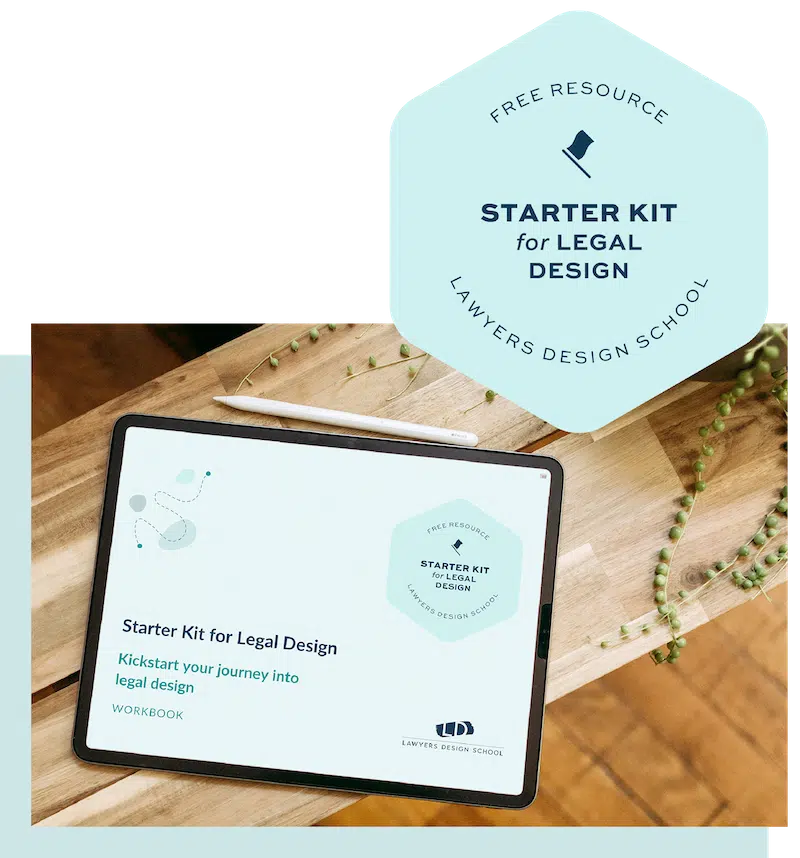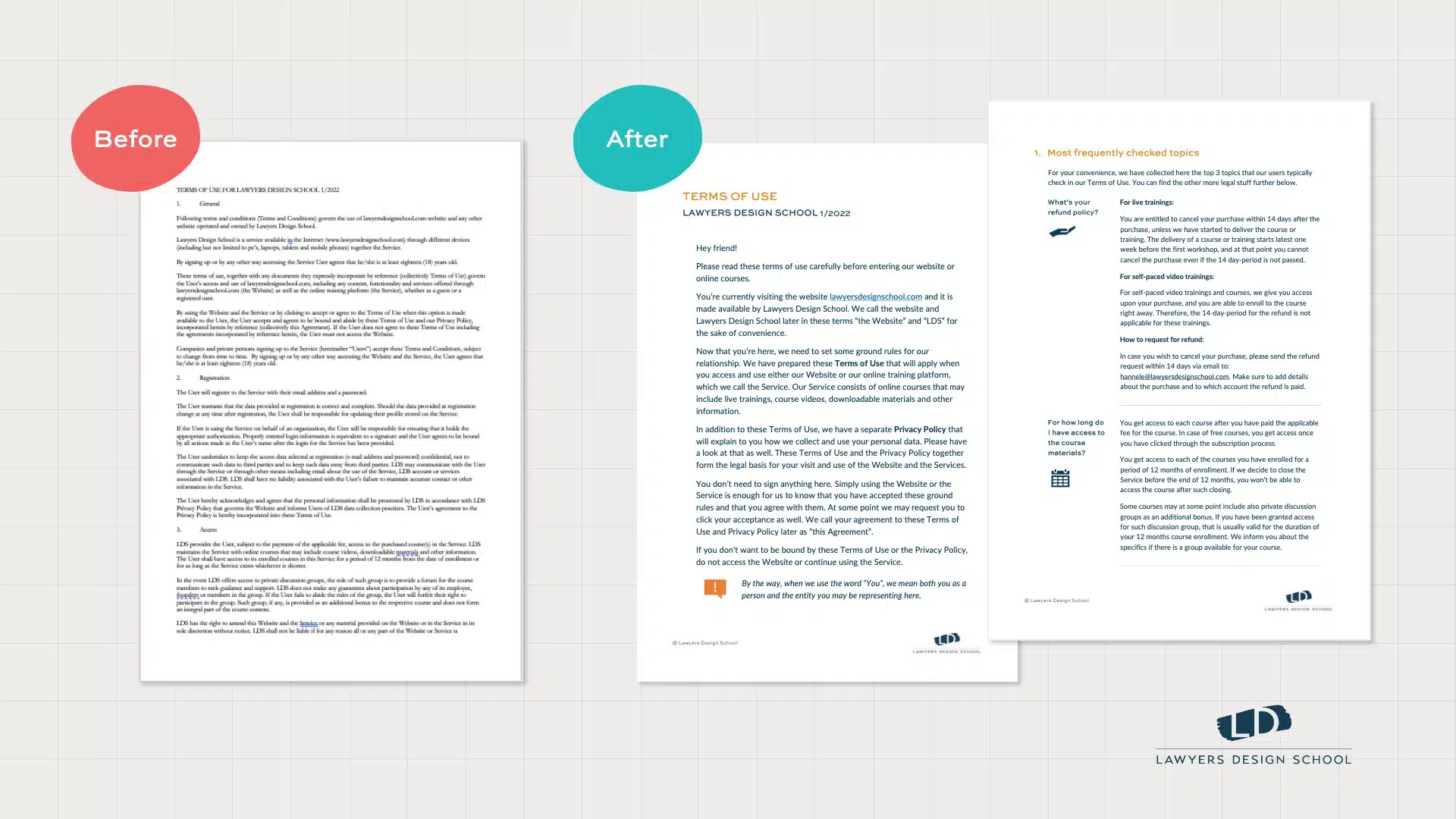I’m Hannele Korhonen, the founder and CEO of Lawyers Design School and I’m on a mission to transform the legal space with human-centred design better known as legal design. My speciality is contract design, so I help lawyers to simplify and visualise user-friendly contracts.
Today our topic is the results of contract design: The outcomes lawyers are seeing when they use contract design in their work.
When I talk about contract design, I’m talking about simplifying and visualizing contracts to make them user-friendly.
I believe that there’s nothing that inspires more action than stories and living examples from lawyers like us. It’s the power of showing, not telling.
Changing how lawyers look at contracts – a backstory
One of the key goals of contract design training is to help lawyers look at their contract documents in a new way – to look beyond the legal substance of the document, especially beyond the contract language and contract structure.
Lawyers are trained to focus on the language and words to the point they don’t see anything else.
And that makes it hard to improve anything other than the words and expressions used in contracts.
And that’s where lawyers get stuck.
A prime example was a workshop I ran on visualizations in legal documents. I use a lot of practical examples in the workshops, and this time I used one page of a contract as an example.
Then I talked about the basic principles of graphic design and how lawyers could use those principles to make contract documents look visually appealing.
I showed the lawyers the same contract after applying different, but basic, graphic design principles to show how the look of the document changed.
Horror! There were some small typos and punctuation errors in the contract text – but they were irrelevant to the point of the exercise. The point was to take a step back and see what the contract page looked like when presented to a user.
When we started to analyze the layout of the contract, all the participants could see and talk about were the typos and grammar errors in the text. Comments were all about, “Hey there’s a typo here and that sentence is missing a comma.” Nothing about the layout!
It’s about the presentation
It was so interesting and eye-opening for me. Because before lawyers can simplify and visualize contracts, it’s vital to learn how to look at contracts from a different perspective.
We need to acknowledge that the way information is presented in contracts is important, not just the legal content.
Of course, the language and the contract text are important, along with simplification of the language (and fixing the grammar) but there’s more to contracts than that.
Any written text is a visual presentation, so lawyers always make a conscious choice about how to present that text, whether they think they do, or not.
It’s your choice – retain the poor UX contract design as the default or design it intentionally.
Which lawyers absolutely can and should do.
What does Contract Design look like
One very visible and concrete result of contract design is the way contracts look after they have been redesigned.
Here’s an example of a redesigned contract.
This is a Terms of Use contract.
The text is probably too small for you to read, but that’s fine, we can focus on the layout of the contract for now, although the language has been simplified too.
On the left, is the original version – a wall of text with small print. The text is not structured in ways that would be useful for the reader – descriptive subtitles or bullet points, for example.
The use of white space is minimal. White space means space in margins or between the text elements.
How do users respond to the traditional Terms of Use?
It takes one second for them to think
- This document is not for me
- I can’t read it
- I don’t have the time or the energy to read it
- I don’t want to read it.
If lawyers are hoping a user would take action on this Terms of Use, it’s unlikely.
What about the redesigned Terms of Use?
The example on the right is the redesigned version of the contract. In this version, we used a lot of different tools and techniques to simplify and visualize the contract. The content is structured in a different way, including various elements like info boxes and icons to pinpoint certain key content. And there’s much more white space around text.
If you were the client presented with these two documents, which one would you prefer to read?
The results of the contract design work
It’s moving away from the walled garden of complex legal information and allowing your clients to own their information – understand it, access it and allow them to approach it feeling much less overwhelm.
It makes the clients the hero in their own case (because it’s their case afterall), and they have agency to make better-informed decisions by themselves.
“Contract design changes don’t have to be big to get big results. It’s not too difficult, not too expensive, but it does require you to start looking at your contracts in a new way and add a few new skills and tools to your lawyer toolbox.”
Contract design example: Visual termsheet
Another example of the results of contract design comes from one my contract design courses.
In this course, the team worked on their own contract with the aim of making the contracting process more smooth and fast. It was a standardized contract with a standardized process distributed in large volumes.
They had already worked on the legal content of the contract. They had made the contract more balanced so that it was not just favoring the other party and leaving all the risk and responsibility to the other. They had received feedback from the users, which was great, and decided to make changes based on that information. So the legal content was fixed.
Reworking the content helps, but it’s not enough
But the legal team got a lot of support requests related to the new, re-worded contract. Clients wanted lawyers to explain certain key clauses again and again.
Key clauses were acceptable but clients didn’t understand them so they wouldn’t accept the contract and close the deal. So even with the newly drafted content, the results they were hoping to achieve – a smooth and fast process, weren’t there.
In the contract design training this team decided to design a visual term sheet to accompany their standard contract. Acknowledging that they did not want to go back changing the contract, they wanted to try another approach.
So they designed a term sheet that included those key clauses in plain language and explainers of few practical examples on what the key clauses meant in practice for the clients.
Result of that contract design course?
A term sheet that helped the legal team to work smarter not harder and most importantly, closed deals faster because clients understood the key content and didn’t need additional rounds of negotiation.
Contract design example: Work with, not for, your clients
This one may surprise you. It’s about improving collaboration and sense of ownership with the help of the contract design process.
It is important to emphasize that the results of contract design are not all about how the contract looks after the design work, or how big are the efficiency gains but also the other non-tangible results of working with contracts in a new way.
Lawyers and clients working on contracts together
One brilliant example of this was a contract design workshop we did and where our client, a law firm, invited their clients to come along. And the workshop was a real deal, each lawyer working on a client’s actual contract with the client. There were no imaginary examples.
Typically lawyers want to practice on their own first, get the hang of the contract design tools before opening the work up to their clients. But this time it was an incredible opportunity for both the law firm and the clients to learn together from the start.
Results of lawyer and client collaboration
When the lawyer-client pairs and small groups started talking about the contract from a usability perspective, they quickly found new ways to clarify the content and add visual elements to it. And since they were co-creating the solutions, there was no sending the new version back and forth, waiting for the response or anything. They got results right there, in the workshop.
They were able to come up with many more ideas within a small group than anyone would have working alone, explain their ideas with making quick prototypes, straighten any misunderstandings right away and decide on the ideas they would take forward.
As a byproduct of the collaborative contract design process, the clients really appreciated the opportunity to learn new skills and the relationship grew stronger with the new kind of conversations they were able to have with each other.
Contract Design ROI
Contract design generates results on many levels.
The return on investment of contract design is both
- The changes you see in the surface, in the hard measurable outcomes: The simplified and visualized contract that clients can understand and close fast – resulting in efficiency, cost savings and more deals
- The underlying changes you see in the minds and hearts of the people participating in the contract work: Changes in relationship building, the way lawyers and contracts are perceived and the way people have conversations about contracts
Aside from the returns I list above, I’m most passionate about reshaping the legal profession so lawyers want to stay in the law (especially the Gen Z lawyers who aren’t into traditional lawyering practices AT ALL).
There is a new way to practice law and we have the power to make it happen.
Legal design thinking: IRL. Episode 29
You’ve just read a summary of my LinkedIn Live.
Each week I provide actionable advice for lawyers and discuss real-life legal design in action. I hope legal design thinking and contract design can help you get more happy clients and be happier lawyers.
I’m running some free contract design webinars in October 2022 if you’re curious – but be quick because they are next week. Otherwise head to our Contract Design School for more information on how you can use contract design to reshape your law.
If you’ve read something that interests you please join me next week.
You can catch a replay of episode 29 here Legal Design Thinking: IRL or join me live and ask questions.
Want to chat about it?
Feel free to DM any questions or join me on LinkedIn every Wednesday at 8 am ET where you can ask me about contract design and legal design and what it means for you.
Follow me at @lawyersdesignschool for more tips and tools.
Prefer email? Drop me an email at [email protected]. And while you’re here, take a peek at the Lawyers Design School and check out other ways to use legal design thinking to grow your law firm and thrive in your business.
Watch all the Legal Design IRL Episodes episodes.

STARTER KIT FOR LEGAL DESIGN
Free resource
Get this free resource to kickstart your journey into legal design.
Add empathy, simplicity, and creativity to your legal work and elevate customer experience.


